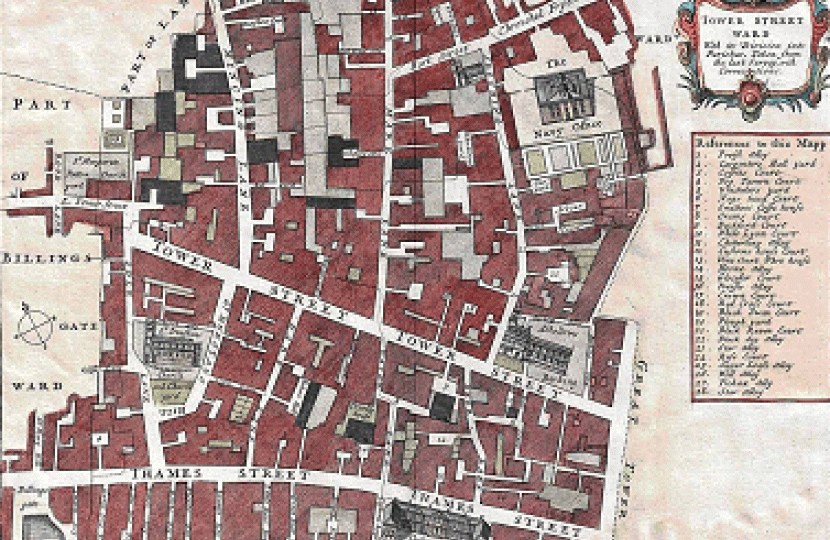
The Wards of the Square Mile are ‘voting districts.' We are part of unique place that is the City of London, with a residential population of approximately 10,000, and a business population of about 350,000. The City wards are each represented by Common Councilmen and Aldermen, elected by the residents and business organisations.
The City of London owns and maintains five Thames bridges, of which is the Tower Bridge the symbol of Tower Ward.
Tower ward has a long history, and its name is linked to the street leading to the Tower of London.
Tower Street Ward (Extracts from John Stow’s “Survay of London” - 1890 edition). John Stow lived c 1525 ~ 1605.
“...now therefore, to begin at the east end of the street (Tower Street - after which the Ward was named) on the north side thereof, is the fair parish church called Allhallows Barking, which standeth in a large, but sometime far larger, cemetery or churchyard; on the north side whereof was sometime built a fair chapel, founded by King Richard I...By the west end of this parish church and chapel lieth Sidon Lane, now corruptly called Sything Lane (Seething Lane), from Tower Street up north to Hart Street...at the north-west corner of this lane standeth a proper parish church of St Olave (Samuel Pepys’ church)...of the said Tower Street Ward. Woodroffe Lane towards the Tower is in this parish. Then have ye out of Tower Street, also on the north side, one other lane, called Marte Lane (Mark Lane) which runneth up towards the north, and is for the most part of this Tower Street Ward...A third lane out of Tower Street, on the north side, is called Mincheon Lane (Mincing) so called of tenements there sometime pertaining to the Minchuns or nuns of St. Helen’s in Bishopsgate Street...The Clothworkers’ Hall is in this lane...And, therefore, to begin again at the east end of Tower Street, on the south side, have ye Bear Lane, wherein are many fair houses, and runneth down to Thames Street. The next is Spurrier Lane, of old times so called, but since and of later time named Water Lane...Then there is Hart Lane for Harp Lane, which likewise runneth down into Thames Street. In this Hart Lane is Bakers’ Hall...This church of St Dunstan is called, in the east, for difference from one other of the same name in the west; it is a fair and large church of an ancient building, and within a large churchyard...(only the picturesque gardens remain). Now for the two church lanes, they meeting on the south side of this church and churchyard, do join in one, and running down to the Thames Street, the same is called St Dunstan’s Hill, at the lower end whereof the said Thames Street towards the west on both sides almost to Belinsgate, but towards the east up to the water gate, by the bulwark of the Tower, is all of Tower Street Ward. In this street, on the Thames side, are divers large landing-places called wharfs or quays...on the north side, as well as on the south of this Thames Street, are many fair houses large for stowage, built for merchants; but towards the east end thereof, namely over against Galley Quay, Wool Quay and the Custom House...This ward hath an alderman, his deputy, common councillors eight, constables thirteen, scavengers twelve, Wardmote men thirteen, and a beadle; it is taxed to the fifteenth at six and twenty pounds.”
Tower Ward is home to three Livery Companies (Bakers, Clothworkers and Cordwainers), part of Great Tower Street, and Trinity House. Trintiy House is an elegant building, the home of the General Lighthouse Authority and the Deep Sea Pilotage Authority, and a source of charity dedicated to the welfare and training of Mariners. We are also home to Fenchurch Street Station; the second half of Pepys Street; Crutched Friars; Savage Gardens; Jewry Street; Carlisle Avenue, plus their environs, and part of Coopers’ Row. Tower also includes the Minories - named for the abbey inhabited by the Nuns of St Clare, and Goodman’s Yard - part of a farm contemporary to Stow, and where he purchased milk as a young boy. This part of the City housed hospitals, almshouses, religious institutions, and open space for public enjoyment, until Henry VIII and commerce caught up with it.
Samuel Pepys lived, worked and worshipped in the Ward - and, of course, wrote his diaries there by candlelight.
